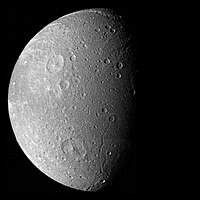Dione (satellite)
Dione is a natural satellite of Saturn discovered in 1684 by Giovanni Cassini; the name comes from Greek mythology. Cassini named the four moons he discovered (Thethys, Dione, Rhea, and Iapetus) Sidera Lodoicea ("the stars of Louis") after King Louis XIV. The Astronomers of the time adopted the convention of naming satellites with Roman numerals, and Dione is also known as Saturn IV. The mythological names of Saturn's satellites were proposed by John Herschel (son of William Herschel, discoverer of Mimas and Enceladus) in his study published in 1847, Results of Astronomical Observations made at the Cape of Good Hope where he suggested the names of the Titans, brothers and sisters of Cronos.
Physical characteristics
Dione is made mostly of frozen water. However, since Dione is Saturn's densest moon (aside from Titan, which is denser due to gravitational compression), it must surely have denser materials inside, such as silicon rocks.
Although slightly smaller, Dione is a moon very similar to Rhea. The two have similar compositions and albedo characteristics, and both exhibit asymmetries in their leading and trailing hemispheres. Dione's forward hemisphere is heavily cratered and uniformly bright. Its rear hemisphere contains a network of bright but not very well defined lines on a dark background sea. Thanks to higher-resolution images from Cassini, it is now known that these lines are actually large ice cliffs.
Scientists recognize the following types of geologic features on Dione's surface:
- Chasmata (cannons)
- Lineae (glacial Cliffs)
- Craters
Lines
Prior to Cassini's close encounter with Dione on December 13, 2004, the origin of the fuzzy lines (detected at low resolution by Voyager in the early 1980s) was not understood. All that was known was that these lines were thin and had a high albedo. One hypothesis was that shortly after its formation Dione was geologically active and some cryovolcanic-type process modified its surface at that time, with streaks or lines forming from eruptions where cracks existed, and icy material falling nearby in the form of snow or dust.. However, high-resolution Cassini images have shown this hypothesis to be incorrect and that these fuzzy lines are not ice deposits, but faults or cliffs of bright ice, created by tectonic fractures. These huge fractures are found in Dione's rear hemisphere. Cassini took highly detailed images from about 500 km on October 11, 2005. Some of these photos were taken from favorable orientations, showing that these glacial cliffs were several hundred meters high.
Craters
Dione's icy surface includes regions of moderate and heavy cratering; slightly cratered plains; and areas of tectonic fractures. Highly cratered regions have numerous craters larger than 100 kilometers in diameter. The plains area has craters smaller than 30 kilometers in diameter. A high fraction of the highly cratered area is located in the trailing hemisphere. This is the opposite of what some scientists expected; E. Shoemaker and Wolfe in 1982 proposed a cratering model for a tidally slowed satellite, where ecliptic comets would fall more often on the leading than trailing hemisphere. This suggests that during the heavy bombardment period, Dione was in an opposite orientation to today. Since Dione is relatively small, an impact capable of causing a crater of 35 kilometers or more could have reoriented the satellite. Since there are many craters larger than 35 kilometers, Dione could have been reoriented several times during the Late Heavy Bombardment period. The pattern of cratering since then and the bright albedo of the leading side suggest that Dione has remained in its current orientation for several billion years. Like Callisto, Dione's craters lack the characteristic relief heights of the Moon and Mercury, this is probably due to deformation of Dione's weak crust over geologic time scales.
Recently, thanks to the Cassini-Huygens mission, it was discovered that both Tethys and Dione are jetting particles into space, indicating some geological activity is present.
Geological activity
In May 2013, the Cassini spacecraft provided evidence that Dione could be more active than predicted. It was thought that it could be a vestige of activity that Cassini previously discovered on Enceladus, another satellite of Saturn. Using stereograph-generated topographic images, some NASA teams suspect that certain foldings across a prominent ridge in the leading hemisphere would only be possible if there were a subsurface ocean. This comes from observations and modeling of Janiculum Dorsa. This mountain has a height of between one and two kilometers. Dione's crust appears to wrinkle half a kilometer below the mountain, suggesting that the icy crust was warm when the ridge formed. The best way to get that heat is for the satellite to have an internal ocean. Dione is also tidally heated as it moves towards and away from Saturn during its orbit.
Trojan satellites
Like Tethys, Dione has two coorbital Trojan satellites: Helena and Pollux, which orbit Saturn at Dione's L4 and L5 Lagrangian points. Pollux is interesting in the sense that it was recently discovered (2004) by the Cassini probe, whereas Helena's existence has been known since 1980.
Exploration
Dione was first photographed by the Voyager space probes. More recently, the Cassini orbiter made up to five close flybys of the satellite. The first flyby was on October 11, 2005 at a distance of 500 km; the next, at the same distance on April 7, 2010; the third was the closest, reaching 99 km on December 12, 2010. 2011; during the fourth, on June 16, 2015, Cassini came as close as 516 km; and the fifth and final occurred on August 17, 2015 at a distance of 474 km.
Contenido relacionado
(24) Themis
Thetis
2004 FH



